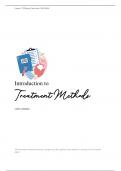Summary
Intro to treatment methods_ mini summary
- Course
- Institution
This is a brief and easy-to-understand summary of the mandatory reading for the Introduction to Treatment Methods course. I've covered all the important points you need to know and made sure that it's written in a way that is easy to follow and read. The text comes together with diagrams, picture...
[Show more]



